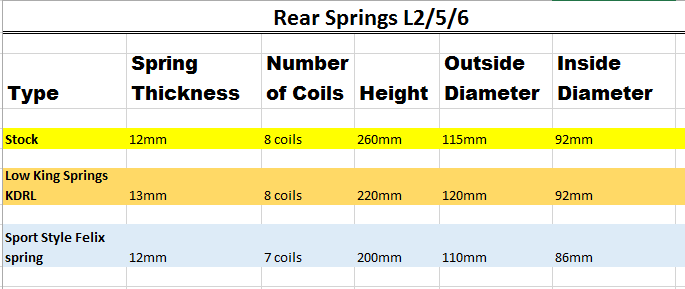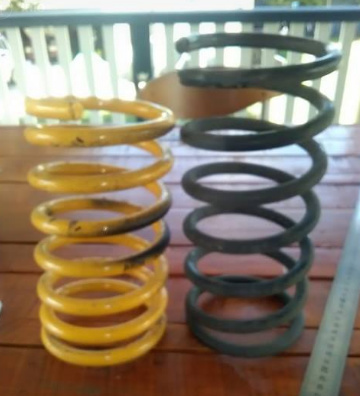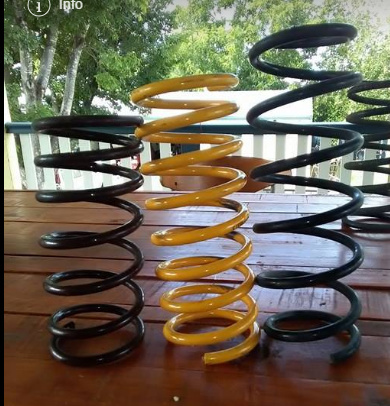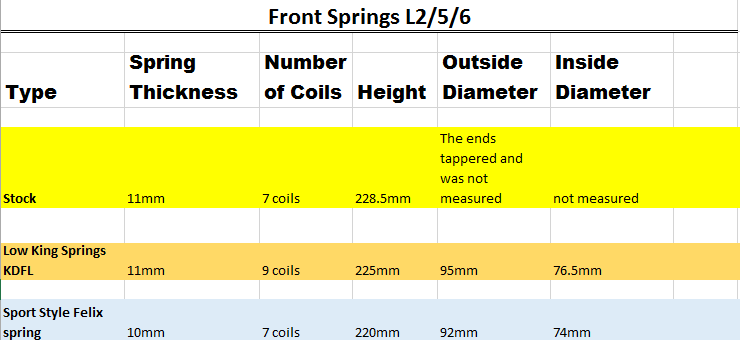Today I changed the springs on my move and decided to document the differences between springs this is what I found as follows:
Rear Spirngs first!!!



Now for the Fronts

So in Summary
Stock Springs
- What can you say they come with the car and are supposed to be what the manufacturer thinks we should have within laws etc.
The Malaysian Springs
- They are great for making your car low and I had trouble getting these to be captive in the the front struts. I did achieve it but when I took them out I found that one had jumped and I was lucky no damage had been done.
-So I was saying if your all about low for your car cheap and don’t want to use cut springs and don’t care how the car rides and handles and can put up with a lot of bounce. Then these are the springs for you.
Low Mira King Springs
-These are my preferred choice of the 3 I have tested.
-These give you a little bit of low but not the really cool low of the Malaysian Springs and if you follow mcm shoe guide to low you can still get at least a shoe in there.
- With that being said about the low not being as low as the Malaysian they are still lower than the stock ones and have a much better ride and feel more solid and stable on the road that what the Malaysian ones ever did. I may even be able to drink from a milk carton again while driving.
-If you prefer ride stiffness with smoothness, better handling but willing to sacrifice some of the low or dont care about lowness of the car then these are the ones to go for.
RSR Low Sirion Springs for the front!
This is a new edition as I Just got some, Before putting them in the car I thought I should do a comparison also.
The rsr springs were pretty much the same as the mira low king springs with the same length and same number of coils with the only difference being 0.5-1mm thinner than the mira kings.
Please note:
The car I have been using for testing is a 1997 auto Daihatsu move with Hyundai excel rear shocks as an upgrade over the stock shocks. Also all of the data and results and opinions are simply what I think and what I have found while doing this and this is intended for information purposes. I am in no way qualified in an field and have just simply undertaken some personal testing and shared my thoughts and results.
I also encourage anyone else to do their own tests to determine what they like and find
8 Likes
Great write up Jimmy. I hope we see more of this from you and others. There is good information there and it was a really beneficial read.
Front wheel drives need soft front and stiff rear. My std front with half a coil off the top and bottom are 115lb/in. Rear std are way to soft. Although I can’t remember the rating I went to 500lb/in in a 2.5" dia 7" long in the back and it was one of the single best handling improvements done to it and a lot had been done (how this was done will be explained in the Gormsby L200 Almost Track Attack info). The difference in rate between the front and rear is not as large as appears since the trailing arms in the rear have more leverage than the front control arms. All the same the rear must be stiffer since it is beneficial to transfer weight to the front. More grip at the front means less understeer due to increased grip and that also means less wheel spin.
Most will understand that cutting springs increases the rate. Sometimes though I have had people argue the contrary. Take half the spring away then half the rate is gone also.
The “rough” ride may not only be due to spring rate but also the shock absorbers (which do not absorb shock - that’s the springs’ job). Better to call them dampers as the control spring oscillation. A spring in motion will release energy and bounce up and down until the energy is gone. The damper needs to take the engergy such that the spring goes up and comes back down in a controlled fashion such that the tire follows the road. A “stronger” spring needs more damping control.
I currently use single adjustable dampers that can be adjusted for rebound. Fronts are Koni Red. These must have the spring removed to be adjusted (it is possible to change bump damping but that requires a change in the foot valve washer stack or an increase in fork oil thickness is also an option). Rears were also Koni (Hyundai) red which were set to full stiff for the 500 springs and latter changed to a single external adjustable (Lotus).
Open end springs are, for me, too expensive to play with. The issue is getting a spring made for a certain make and model of car is much greater than a coil over type of spring (ie a 1 7/8", 2", 2 1/4" or 2 1/2" inside diameters and range of standardised lengths with closed and ground ends) are for universal fitment and hence cheaper options. Spring perches can be changed without the need for a threaded adjuster. I held off for as long as possible on going to a coil over on the front since the faoctory rate was about right for the road. And then I was compelled to go to a 1 7/8" to clear the larger diameter tires I was switching to (some weight reduction too came about which is good but would not have been reason enough to change unless a championship or sheep station was at stake. Unless for the track I do not like threaded adjusters since they can attract all the wrong attention. To get corner weight right without adjusters I have just used shims under springs - not practical but works. Paint everything black and if you must have adjusters cover them with a rubber bike tube (I have never had hassle from the Police for owning a modified vehicle other than for induction noise (twin webbers on a 2.4l L series Datsun and being an idiot-these days I still an idiot but in different ways), mine has often been passed over, while friends with “pretty” painted suspension got into considerable trouble (anodized parts under the engine bay didn’t help their cause either). As a broad rule, for most qld roads just make sure there is a minimum of 50mm bump and 50mm drop in suspension travel.
Doing like Jim will really help people to move forward. When I do that sort of recording it’s normally by writing on a steel post in pencil, on a white board or something else as equally temporary. The next step with spring info would be to put the data into a spring rate calc. There are a heap out there and some more accurate than other since more variables help or real testing of load can give a real rating. http://www.pontiacracing.net/js_coil_spring_rate.htm
3 Likes
Nothing like an Honest Comparison, not pushing any particular one just your own opinion, Excellent Write Up Evil 
2 Likes
Of course theres more than one Malaysian brand though dont forget. I’ve had good experience with the APM Performax brand personally
1 Like
yeh thats why in the table i state it as the felix sport spring
1 Like





